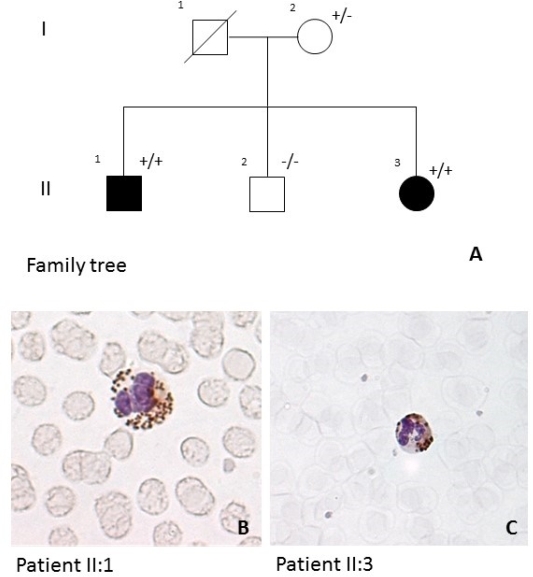Session Information
Date: Tuesday, June 21, 2016
Session Title: Genetics (NON-PD)
Session Time: 12:30pm-2:00pm
Location: Exhibit Hall located in Hall B, Level 2
Objective: To report two siblings affected by Chediak-Higashi syndrome (CHS) presenting with a pure neurological phenotype including paediatric and adult-onset parkinsonism.
Background: CHS is a rare autosomal recessive disorder caused by mutations in the lysosomal trafficking regulator gene (LYST). Classical CHS presents in infancy with immunodeficiency, partial oculocutaneous albinism, bleeding diathesis and hemophagocytic lymphocytosis. Rare adult-onset cases with heterogeneous neurological phenotypes, including movement disorders, have been reported.
Methods: Two siblings from a non-consanguineous Italian family were examined (Fig. 1A). The brother (II:1), aged 49, presented at age 23 with shuffling gait and later developed a progressive paraparesis, non-pigmentary retinopathy and mild akinetic-rigid parkinsonism responding to dopaminergic therapy in the upper limbs. His sister (II:3) presented at age 14 with shuffling gait and tremulous asymmetric parkinsonism in the upper limbs with slowly progressive course and good response to LD. At the age of 34, she had motor wearing-off with freezing of gait and severe tremor of the four limbs and tongue. Both siblings had a history of frequent epistaxis requiring cauterization but no recurrent infections were reported. After extensive genetic tests including recessive PD-associated genes, next generation sequencing (NGS) was performed on MiSeq platform through the TruSight One Sequencing Panel (Illumina) that provides comprehensive coverage of 4.813 clinically relevant genes. The variants called were analysed by a series of filtering steps to identify the causative mutations.
Results: Two different mutations in the LYST gene were identified (p.E1441fs/p.N3376S) in both siblings; the p.N3376S mutation was inherited from the unaffected mother; another healthy brother resulted wild type. The probands’ father had died and DNA analysis was not performed. Both patients had abnormal DAT-Scan. Brain MRI showed severe (II:1) and mild (II:3) cortico-subcortical atrophy. Peripheral blood smear revealed characteristic large peroxidase-positive granules within leukocytes (Fig. 1B-C) 
Conclusions: CHS can present with heterogeneous clinical phenotypes even within the same family, including childhood-onset LD responsive parkinsonism with tremor. Frequent epistaxis can be the only clue to diagnosis. NGS is a powerful tool to achieve a genetic diagnosis in rare diseases with atypical presentations.
To cite this abstract in AMA style:
M. Carecchio, E. Salsano, A. Legati, C. Lamperti, E. Corsini, B. Garavaglia, D. Pareyson, D. Ghezzi. Paediatric and adult-onset parkinsonism in Chediak-Higashi disease: A new family [abstract]. Mov Disord. 2016; 31 (suppl 2). https://www.mdsabstracts.org/abstract/paediatric-and-adult-onset-parkinsonism-in-chediak-higashi-disease-a-new-family/. Accessed April 3, 2025.« Back to 2016 International Congress
MDS Abstracts - https://www.mdsabstracts.org/abstract/paediatric-and-adult-onset-parkinsonism-in-chediak-higashi-disease-a-new-family/
